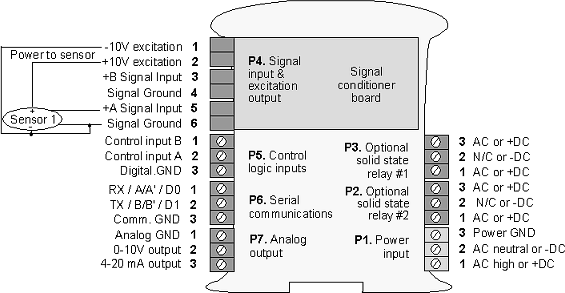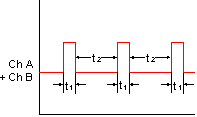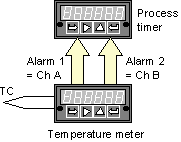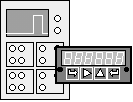

Quick Reference
Panel Meters
- DC Panel Meter
- Temperature Meter
- Process & Strain Meter
- Linearizing Meter
- True AC RMS Meter
- Load Cell & Microvolt Meter
- Scale / Weight Meter
- Frequency Counter, Rate Meter, Period Meter
- Process Receiver & Integrating Totalizer (analog input)
- Time Interval & Stopwatch
- Quadrature Position & Rate
- Batch Controller (analog input)
- 6-Digit Remote Displays
- Setpoint Controller Options
- AC & DC Power Options
- Analog Output Option
- Compact 1/8 DIN Case | RS-232 & RS-485 Options
- BCD Output Option
- Modbus Transmitters
- 4-20 mA Transmitters
- DC Voltage Transmitters
- Dual Chanel Frequency Transmitters
- Serial Input Transmitters
- Duty Cycle Transmitters
- DC Voltage Transmitters
Counters
Remote Displays
Options & Mechanicals
Modbus Transmitters
Time Interval of Periodic Events 4-20 mA Current Transmitter
From from 1 µs to 199.999 s. Resolution to 0.2 µs.
DIN Rail mounted, digitally programmable.
Features
- Isolated 4-20 mA or 0-10V transmitter outputs, selectable.
- For periodic events with width from 1 µs to 199.999 s.
- Resolution to 0.2 µs.
- Timing duration to 999,999 hrs
- Inputs from NPN or PNP proximity switches, contact closures, digital logic, magnetic pickups down to 12 mV, or AC inputs up to 250 Vac.
- Easy setup using Laurel's PC-based Instrument Setup Software.
- Output resolution: 0.025% of span (12 bits).
- Transmitted 6-digit decimal reading.
- Rep rated to 250 kHz.
- Trigger on positive or negative pulse edges.
- DIN rail mount package only 22.5 mm thick.
- Optional dual solid state relays for alarm or control.
- 5V, 10V or 15V dc excitation output to power transducers.
Description
The Laureate 4-20 mA transmitter for periodic time events can transmit pulse width or time delay between individual pulses to a resolution of 0.2 µs. It can also display average pulse width or average time delay between multiple pulses. Selectable full-scale ranges go from 0.099999 sec with 0.2 µs resolution (after averaging) to 199.999 sec with 1 ms resolution.
Time interval is measured between inputs on channels A and B. Timing starts when a pulse is applied to Channel A (selectable positive or negative edge), and ends when a pulse is applied to Channel B (selectable positive or negative edge). In case of a single pulsed signal, the A and B inputs can be tied together. A positive or negative slope may be selected to start timing, and the opposite slope must be selected to stop timing. Timing is achieved by counting 5.5 MHz clock pulses. Multiple integral time intervals are averaged over a gate time which is selectable from 10 ms to 199.99 s and also controls the maximum output rate.
Universal Signal Conditioner
The dual-channel signal conditioner used for pulse detection accepts inputs from proximity switches with PNP or NPN output, TTL or CMOS logic, magnetic pickups, contact closures, and other signals from 12 mV to 250 Vac. Jumper selections provide optimum operation for different sensor types and noise conditions. A built-in isolated 5V, 10V or 15V dc excitation supply can power proximity switches and other sensors, and eliminate the need for an external power supply.
Transmitter Options
The analog transmitters output can be selected as 4-20 mA or 0-10V, and is isolated to avoid ground loops. The output is generated by an ultra-linear 12-bit (4096 step) digital-to-analog convert (DAC), whose span can be adjusted from 0 to ±999,999 internal counts and zero can be adjusted from -999,999 to +999,999 internal counts. The analog output has a rated accuracy of ±0.05% of output span.
Transmitter programming is via the unit's three-terminal serial port using Laurel's PC-based Instrument Setup Software. This software can be downloaded from this website at no charge. The required transmitter-to-PC interface cable is available from Laurel (P/N CBL03). Laurel's serial output transmitters and meters can also be part of PC-based data logging systems using Laurel's Datalogging Software, which operates under the Laurel ASCII Protocol. A single software command switches between the Modbus and Laurel ASCII Protocols.
Specifications
| Pulse Input | |
| Types | AC, pulses from NPN, PNP transistors, contact closures, magnetic pickups. |
| Signal Ground | Common ground for channels A & B. |
| Minimum Signal | Nine ranges from (-12 to +12 mV) to (+1.25 to +2.1V). |
| Maximum Signal | 250 Vac |
| Maximum Frequency | 1 MHz, 30 kHz, 250 Hz (selectable). |
| Contact Debounce | 0, 3, 50 ms (selectable). |
| Time Base Accuracy | Quartz crystal calibrated to ±2 ppm. |
| Span Tempco | ±1 ppm/°C (typ) |
| Long-term Drift | ±5 ppm/year |
| Time Interval Mode | |
| Timing Start | Channel A pulse, + or - edges |
| Timing Stop | Channel B pulse, + or - edges |
| Periodic Timing Interval | Gate time + 30 ms + 0-2 time intervals |
| Gate Time | Selectable 10 ms to 199.99 s |
| Time Before Zero Output | Selectable 10 ms to 199.99 s |
| Resolution | |
| 0 - 199.999 s | 1 ms |
| 0 - 99.9999 s | 100 µs |
| 0 - 9.99999 s | 10 µs |
| 0 - .999999 s | 1 µs |
| 0 - .099999 s | 0.2 µs (after averaging) |
| Transducer Excitation Output (standard) | |
| Jumper Selection 1 | 10V @ 60 mA, isolated to 50V from signal ground |
| Jumper Selection 2 | 5V @ 50 mA, isolated to 50V from signal ground |
| Jumper Selection 3 | 15V @ 60 mA, non-isolated |
| Dual Relay Output (optional) | |
| Relay Type | Two solid state relays, SPST, normally open, Form A |
| Load rating | 120 mA at 130 Vac or 170 Vdc, 28 ohms series resistance. |
| Analog Output (optional) | |
| Output Levels | 0-20 mA, 4-20 mA or 0-10 Vdc (selectable) |
| Compliance, 4-20 mA | 10V ( 0-500 ohm load ) |
| Compliance, 0-10V | 2 mA ( 5 kOhm load ) |
| Output Resolution | 12 bits (4,096 steps) |
| Output Accuracy | ±0.05% of output span |
| Output Isolation | 250V rms working, 2.3 kV rms per 1 minute test |
| Power Input | |
| Standard power | 95-240V AC ±10% or 90-300V DC |
| Low power option | 12-30V AC or 10-48V DC |
| Frequency | DC or 47-63 Hz |
| Power Isolation | 250V rms working, 2.3 kV rms per 1 min test. |
| Mechanical | |
| Case Dimensions | 120 x 101 x 22.5 mm |
| Case Mounting | 35 mm rail per DIN EN 50022 |
| Electrical Connections | Detachable screw clamp plug connectors |
| Environmental | |
| Operating Temperature | 0°C to 70°C |
| Storage Temperature | -40°C to 85°C |
| Relative Humidity | 95% at 40°C, non-condensing |
Typical Applications
Time Interval Mode for Time Delay
For periodic pulses applied to A and B channels, time delays can be measured down to 0.2 µs resolution from the rising or falling edge of A to the rising or falling edge of B (selectable).
Time Interval Mode for Pulse Width
The width of periodic pulses (t1 or t2) can be measured by tying the A and B channels together. As for time delay, readings are averaged over a user-selectable gate time.
Timing Process Dynamics with a Panel Meter and Time Interval Meter
The start and stop pulses used for timing can be generated by the dual relay board in a Laureate panel meter or digital counter. For instance, the start and stop pulse edges can be created as temperature passes two alarm setpoints, or temperature cycles in a hysteresis control mode.
Replacing an Oscilloscope with a Laureate Time Interval Meter
An oscilloscope is great for viewing and timing pulses in a lab. However, in fixed installations where digital timing accuracy and control outputs are required, a low-cost Laureate time interval meter will be the instrument of choice. Resolution to 0.2 µs is feasible.
Instrumenting a Pulsed Laser System

Some of the many possibilities in instrumenting a pulsed laser system with Laureate dual-channel counters and transmitters: elapsed time, number of pulses, pulse width, pulse separation, duty cycle, and pulse rep rate.
Pinout Laureate Serial Output Transmitters
Pulse Input for Frequency, Rate or Period
(shown with optional analog output and dual relay output)
Pulse Input for Frequency, Rate or Period
(shown with optional analog output and dual relay output)
 |
|
| Transmitter Powering a Single Sensor | |
 |
 |
| Transmitter Powering Two Sensors | Transmitter with Active or Passive Sensors |
5672 Bolsa Avenue Huntington Beach, CA 92649 - USA - Ph (714) 622-2000 - Fax (714) 622-2001






